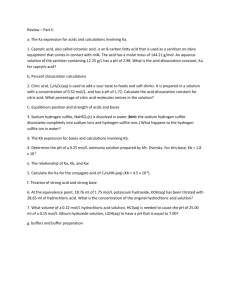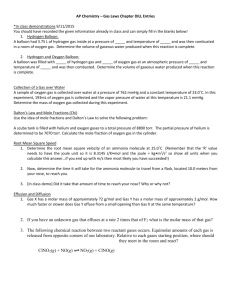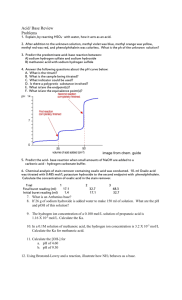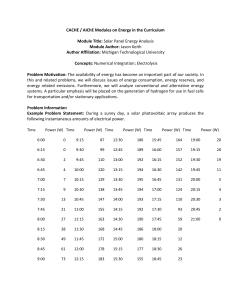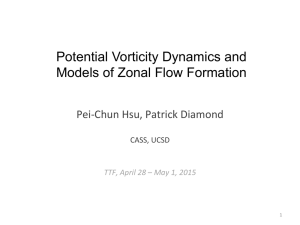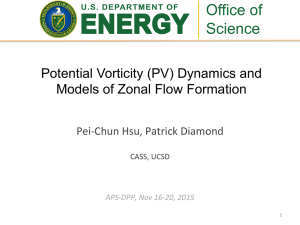NONLINEAR DYNAMICAL BOUNDARY-VALUE PROBLEM OF HYDROGEN THERMAL DESORPTION
advertisement
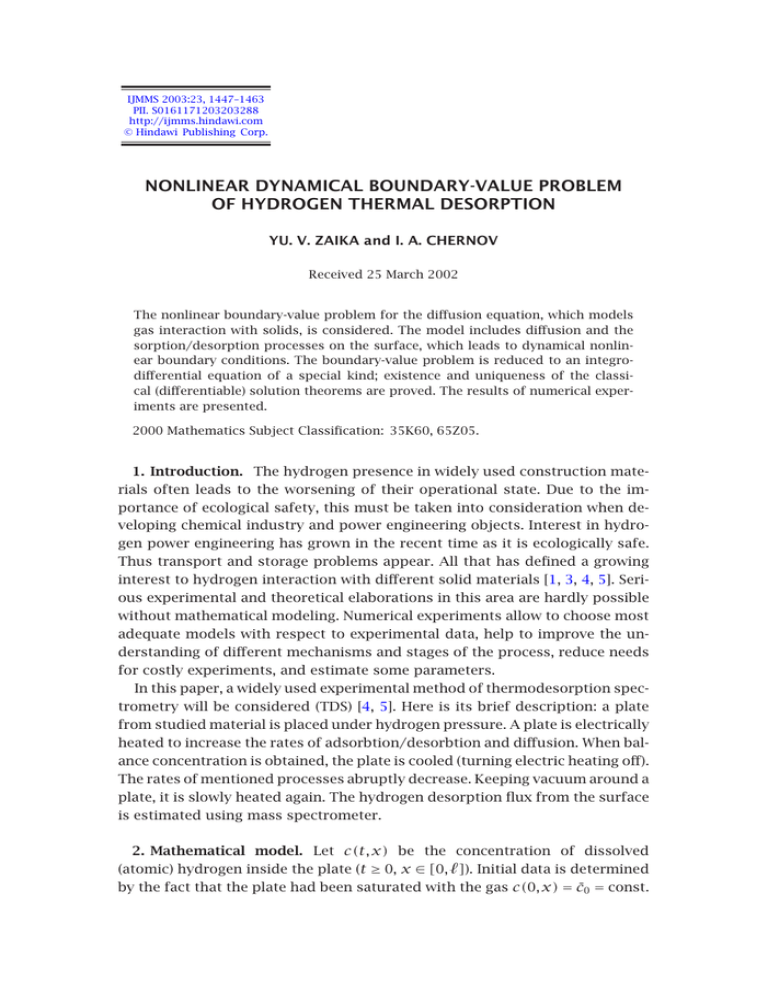
IJMMS 2003:23, 1447–1463
PII. S0161171203203288
http://ijmms.hindawi.com
© Hindawi Publishing Corp.
NONLINEAR DYNAMICAL BOUNDARY-VALUE PROBLEM
OF HYDROGEN THERMAL DESORPTION
YU. V. ZAIKA and I. A. CHERNOV
Received 25 March 2002
The nonlinear boundary-value problem for the diffusion equation, which models
gas interaction with solids, is considered. The model includes diffusion and the
sorption/desorption processes on the surface, which leads to dynamical nonlinear boundary conditions. The boundary-value problem is reduced to an integrodifferential equation of a special kind; existence and uniqueness of the classical (differentiable) solution theorems are proved. The results of numerical experiments are presented.
2000 Mathematics Subject Classification: 35K60, 65Z05.
1. Introduction. The hydrogen presence in widely used construction materials often leads to the worsening of their operational state. Due to the importance of ecological safety, this must be taken into consideration when developing chemical industry and power engineering objects. Interest in hydrogen power engineering has grown in the recent time as it is ecologically safe.
Thus transport and storage problems appear. All that has defined a growing
interest to hydrogen interaction with different solid materials [1, 3, 4, 5]. Serious experimental and theoretical elaborations in this area are hardly possible
without mathematical modeling. Numerical experiments allow to choose most
adequate models with respect to experimental data, help to improve the understanding of different mechanisms and stages of the process, reduce needs
for costly experiments, and estimate some parameters.
In this paper, a widely used experimental method of thermodesorption spectrometry will be considered (TDS) [4, 5]. Here is its brief description: a plate
from studied material is placed under hydrogen pressure. A plate is electrically
heated to increase the rates of adsorbtion/desorbtion and diffusion. When balance concentration is obtained, the plate is cooled (turning electric heating off).
The rates of mentioned processes abruptly decrease. Keeping vacuum around a
plate, it is slowly heated again. The hydrogen desorption flux from the surface
is estimated using mass spectrometer.
2. Mathematical model. Let c(t, x) be the concentration of dissolved
(atomic) hydrogen inside the plate (t ≥ 0, x ∈ [0, ]). Initial data is determined
by the fact that the plate had been saturated with the gas c(0, x) = c̄0 = const.
1448
YU. V. ZAIKA AND I. A. CHERNOV
In the area Qt∗ = (0, t∗ ) × (0, ), concentration satisfies the diffusion equation
ct (t, x) = D(T )cxx (t, x).
(2.1)
Here, t∗ is the duration of the TDS experiment, is the width of the plate,
D is the diffusion coefficient, and T = T (t) represents the temperature. Limit
values of T are known: T (t) ∈ [T − , T + ], 0 < T − < T + , and T (·) ∈ C 1 [0, t∗ ].
Linear heating is often used (in the area [T − , T + ]). For hydrogen at usual range
of pressure, concentration, and temperature, the dependence of all parameters
on T is well described by Arrhenius rule: D(T ) = D0 exp{−ED /[RT ]}. Later in
this paper D(t) = D(T (t)).
We describe the boundary conditions. Considering physical and chemical
processes on the surface, the following dynamical conditions will be used [4]:
2
(t) ± D(T )cx (t, x)|x=0, .
q̇0, (t) = µs(T )p(t) − b(T )q0,
(2.2)
This is a differential equation for surface concentrations q0 (t), q (t), on both
faces of the plate: x = 0, x = . Hydrogen atoms form molecules and desorb from the surface. The density of desorption flux for hydrogen depends
quadratically on the concentration of atoms on the face
2
(t),
J0, (t) = b(t)q0,
Eb
.
b(t) = b T (t) , b(t) = b0 exp − RT (t)
(2.3)
Pressure p(t) of gas hydrogen makes some amount of gas to return to the
surface—it defines the first term in the right part of (2.2) (µ, s(T ) are the
physical constants). The last term in (2.2) defines the diffusion flux of hydrogen
atoms from the deep to the surface. The experiment is symmetrical
q(t)=q0 (t) = q (t),
J(t) = J0 (t) = J (t),
c(t, x) = c(t, − x),
x ∈ [0, ].
(2.4)
The pressure is measured as
t
p(t) = θ1
J(τ) exp
0
(τ − t)
dτ,
θ0
(2.5)
constants θi are defined by technical details of the experimental equipment.
The density of desorption flux can be found from the pressure p(t) for all
t ≥ 0, J(t) = (ṗ(t) + p(t)/θ0 )/θ1 .
If the vacuum system is powerful, the hydrogen return to the surface can be
considered negligibly small. As all processes are symmetrical with respect to
NONLINEAR DYNAMICAL BOUNDARY-VALUE PROBLEM
1449
the middle of the plate, later in this paper we consider one equation instead
of (2.2)
q̇(t) = −b(t)q2 (t) + D(t)cx (t, 0).
(2.6)
The process of hydrogen remissing is considered fast enough, so linear connection between surface and subsurface concentrations can be efficiently used
Eg
.
g(t) = g0 exp −
RT (t)
c(t, 0) = c0 (t) = g(t)q(t),
(2.7)
In this paper, the dependence of parameter on temperature is not important.
So the model of TDS experiment looks like
ct (t, x) = D(t)cxx (t, x),
c(0, x) = c̄0 ,
(t, x) ∈ Qt∗ ,
c(t, x) = c(t, − x),
c(t, 0) = g(t)q(t),
x ∈ [0, ],
(2.8)
2
q̇(t) = −b(t)q (t) + D(t)cx (t, 0).
The main specificity of this boundary-value problem is in nonlinear dynamical boundary conditions.
More general problem from the viewpoint of generalized solutions has been
studied in [8]. Some algorithms of parametric identification of hydrogen penetration models for stratified materials can be found in [3, 9, 10]. In this paper,
the existence of classical solution of the given problem will be studied.
To simplify mathematical operations on the problem, we exclude the vari
t
able q and consider new time t = 0 D(τ)dτ. New time will be represented by
the same letter t. After these transforms, the problem will be
ct (t, x) = cxx (t, x),
c(0, x) = c̄0 = const,
ċ0 (t) =
(t, x) ∈ Qt∗ ,
(2.9)
x ∈ [0, ],
(2.10)
−α1 (t)c02 (t) + α2 (t)c0 (t) + g(t)cx (t, 0),
c0 (t) = c(t, 0),
c(t, x) = c(t, − x),
α1 (t) =
b
,
Dg
x ∈ [0, ].
α2 (t) =
ġ
,
g
(2.11)
(2.12)
3. Reducing the problem to an integrodifferential equation. Let C 1,2 (Qt∗ )
be a space of functions on Qt∗ = [0, t∗ ] × [0, ], which has continuous partial
derivatives ∂ α+β /∂t α ∂x β (here α, β are nonnegative integers, 2α + β ≤ 2) on
Qt∗ and these derivatives can be continuously extended to Qt∗ [7].
Definition 3.1. Classical solution of the boundary-value problem (2.9),
(2.10), (2.11), and (2.12) is a function c(t, x) ∈ C 1,2 (Qt∗ ), which is symmetrical (2.12) and satisfies the diffusion equation (2.9) in Qt∗ with initial data
(2.10) and dynamical boundary condition (2.11).
1450
YU. V. ZAIKA AND I. A. CHERNOV
Let A(t) = c0 (t) = c(t, 0) and assume that classical solution exists. We consider a function c 0 (t, x) = c(t, x) − A(t). Obviously, c 0 (t, 0) = c 0 (t, ) = 0,
cx0 (t, 0) = −cx0 (t, ). It can be extended oddly to [−, ] and thus periodically
on R1 . Then, c 0 (t, ·) ∈ C 1 (R1 ) and on the segment of interest [0, ] it can be
expanded to uniformly converging Fourier series by sine. Thus, it is possible
to try to find the solution in Qt∗ as
c(t, x) = A(t) +
∞
Kn (t) sin
n=1
π nx
.
(3.1)
Formally substitution c(t, x) to the diffusion equation (2.9) gives
∞ K̇n (t) +
n=1
Kn (t)π 2 n2
π nx
sin
= −Ȧ(t).
2
(3.2)
Making a scalar product in L2 [0, ] of (3.2) and sin(π nx/), we obtain the
system of differential equations for Kn (t)
Kn (t)π 2 n2
4Ȧ(t)
, n = 2k − 1,
=−
2
πn
Kn (t)π 2 n2
K̇n (t) +
= 0, n = 2k, k = 1, 2, 3, . . . .
2
K̇n (t) +
(3.3)
Initial conditions come from fixing t = 0 in (3.1), and from initial data (2.10)
we see that Kn (0) = 0, Kn (t) ≡ 0 if n = 2k, and for n = 2k − 1
Kn (t) = −
4
πn
t
0
Ȧ(τ)εn (t − τ)dτ,
πn 2
εn (t) = exp −
t .
(3.4)
will be used as a sum by odd natural n. ObLater in this paper, the symbol
viously, c(t, x) = c(t, − x) and only boundary condition (2.11) is unsatisfied
(formally yet). After substituting (3.1) into (2.11), assuming that series can be
differentiated term by term, we obtain the main equation for A(t)
Ȧ(t) = −α1 (t)A2 (t) + α2 (t)A(t) − α3 (t)
b
ġ
,
α2 (t) = ,
Dg
g
πn 2
t ,
εn (t) = exp −
α1 (t) =
t
0
Ȧ(τ)εn (t − τ)dτ,
4g
,
.
α3 (t) =
=
(3.5)
n=1,3,5,...
Definition 3.2. The solution of (3.5) on segment I = [ 0, t + ] is a function
A(t) ∈ C 1 (I), which satisfies (3.5) for all t ∈ I as well as initial condition A(0) =
c̄0 . The series in the right part converge for all t ∈ I, derivatives on the ends of
I are left or right.
NONLINEAR DYNAMICAL BOUNDARY-VALUE PROBLEM
1451
t
Specificity of this equation is in the term
0 . If, instead of it, there was
a function of time only, not depending on A, it would be a Riccati equation,
which is well studied in the theory of differential equations. The derivative Ȧ
is present in both parts of the equation. It is impossible to use integration by
parts (to remove Ȧ) for one of the series will become divergent. Here appears
an analogy with functional differential equations of neutral type [6]. Due to
divergence, it is impossible to interchange an integral and a sum in the right
part of (3.5). All this makes the study of (3.5) an interesting mathematical
problem.
It is important to note that if there exists a solution on I, then series
t
0
Ȧ(τ)εn (t − τ)dτ
(3.6)
converges on I uniformly and absolutely as |Ȧ| ≤ L (is limited),
t
t
L2
Ȧ(τ)εn (t − τ)dτ ≤ L εn (t − τ)dτ ≤ 2 2 .
0
π n
0
(3.7)
This numerical series converges. The value of the sum is estimated by L2 /8.
The initial boundary-value problem is reduced to this integrodifferential
equation (3.5) in the following sense. Assume that the solution A(t) exists
on I = [0, t + ]. We define the following boundary-value problems:
ct (t, x) = cxx (t, x),
c(0, x) = c 0 ,
c(t, 0) = c(t, ) = A(t).
(3.8)
Such problems are well studied in [7]. The symmetry of initial and boundary
conditions implies that c(t, x) = c(t, − x). Classical solution which exists is
unique and can be found as a convergent in C 1,2 trigonometric series. Thus a
formal series (3.1), built earlier, will present a classical solution and all operations at it were legal.
4. Obtaining solution A(t). Equation (3.5) differs from Riccati equation by
the fact that instead of differential operator d/dt the integrodifferential one is
. So we consider a functional differential probpresent, containing a series
lem on I = [0, t + ]
Ȧ(t) + α3 (t)
A(0) = c 0 ,
t
0
Ȧ(τ)εn (t − τ)dτ = f (t),
(4.1)
4g
∈ C 1 (I),
α3 =
f ∈ C(I).
Let B(t) = Ȧ(t) and define an iterative process
B0 (t) = 0
A0 (t) = c̄0 ,
Bk+1 (t) + α3 (t)
t
0
Bk (τ)εn (t − τ)dτ = f (t).
(4.2)
1452
YU. V. ZAIKA AND I. A. CHERNOV
In case Bk is continuous, |Bk | ≤ Lk on I and
converges absolutely and uniformly (being majorized by a convergent series as explained above). Due to
B0 , B1 = f ∈ C(I), one can obtain that a sequence Bk (t) on I is defined correctly and Bk ∈ C(I).
We now study the convergence. Consider a series B0 + (B1 − B0 ) + (B2 − B1 ) +
· · · which is equal to the sequence Bk . Later, we will use a norm C(I): · =
· C(I) . The following estimations are true:
B0 = 0,
B1 − B0 = f ,
t
B2 (t) − B1 (t) = α3 (t)
f (τ)εn (t − τ)dτ ≤ α3 · f · Ψ (t),
0
(4.3)
where
Ψ (t) =
t
0
εn (t − τ)dτ =
2
nπ 2
t .
1
−
exp
−
(nπ )2
(4.4)
2
/(π n)2 . A function Ψ (t) has the followA series for Ψ on I is majorized by
ing properties: Ψ (0) = 0, Ψ (t) > 0 when t > 0, Ψ (t) grows on t, and Ψ (t) ≤ 2 /8.
Each term is continuous, so Ψ ∈ C(I) and Ψ = Ψ (t + ).
We have obtained an estimation B2 − B1 ≤ α3 · f · Ψ (t + ). Now, only
local solution will be constructed since its continuation is a subject of a special
study. Let t + be such that α3 Ψ (t + ) ≤ r < 1. Then,
B2 − B1 ≤ r f ,
t B3 − B2 ≤ B2 (τ) − B1 (τ)εn (t − τ)dτ α3 (t)
0
+
≤ α3 · B2 − B1 · Ψ t ≤ r B2 − B1 ≤ r 2 f .
(4.5)
Continuing this process, one obtains Bk ⇒ B ∈ C(I) and
B ≤ B0 + B1 − B0 + · · · ≤ ρf ,
ρ=
1
.
1−r
(4.6)
Estimation (4.6) implies continuous dependence B = Ȧ of f .
Theorem 4.1. For sufficiently small t + (α3 · Ψ (t + ) < 1), the unique solution A ∈ C 1 (I) of (4.1) exists for all f ∈ C(I).
t
The existence is proved, A(t) = c̄0 + 0 B(τ)dτ. Suppose that there exists
one more solution F ∈ C 1 (I). Using linearity of (4.1), from (4.6), one obtains
B − Ḟ = 0, which means that A = F on I. If F exists on a smaller segment
J = [0, t 0 ], then t + is reduced to t 0 (Ψ (t) → 0 monotonically when t → 0). Then,
A = F on J and a solution A can be considered as continuation of F from J
to I.
NONLINEAR DYNAMICAL BOUNDARY-VALUE PROBLEM
1453
Remark 4.2. The condition α3 ·Ψ (t + ) < 1 is true without any limitations
on t + if g < 2/, for α3 = 4g/, Ψ ≤ 2 /8. These limitations are tributes to
the method of contractive mappings.
Theorem 4.3. The unique solution A ∈ C 1 (I) of (4.1) with continuous right
part f exists on any segment I = [0, t + ], the following estimation is true: Ȧ ≤
Rf .
Proof. As T (t) ∈ [T − , T + ], we choose t1+ so that the following inequality
holds: α3 · Ψ (t1+ ) ≤ r < 1. The solution will be constructed on I1 = [0, t1+ ] in
accordance with Theorem 4.1. From (4.6), it follows that ȦI1 ≤ (1−r )−1 f I1 .
We consider (4.1) on the next segment I2 = [t1+ , 2t1+ ] with initial data A(t1+ )
Ȧ(t) + α3 (t)
t
t1 +
f˜(t) = f (t) − α3 (t)
Ȧ(τ)εn (−τ)dτ = f˜(t),
(4.7)
t1 +
εn (t)
Ȧ(τ)εn (−τ)dτ.
0
Noting that
εn (t) = εn t − t1+ εn t1+ ,
εn (−τ) = εn t1+ − τ εn − t1+ ,
εn (0) = 1,
(4.8)
and moving the origin to t1+ , one obtains problem (4.1) with modified right part.
Estimation (4.6) implies that ȦI2 ≤ ρf˜I2 . We estimate f˜I2 as follows:
f˜(t) ≤ f (t) + α3 (t) εn t − t + εn t +
1
1
≤ f (t) + α3 I2 · ȦI1 · Ψ t1+ ,
t+
1
0
Ȧ(τ)εn (−τ)dτ
0 < εn t − t1+ ≤ 1, t ∈ I2 ,
(4.9)
f˜ ≤ f I + r ȦI ≤ f I + r (1 − r )−1 f I .
I2
2
1
2
1
From here, the following is easily obtained:
ȦI2 ≤ ρ f˜I2 ≤ ρ f I2 + r ρf I1
≤ ρ(1 + r ρ)f I1 ∪I2 = ρ 2 f I1 ∪I2 .
(4.10)
Comparing this result with ȦI1 ≤ (1 − r )−1 f I1 , 0 < r < 1, we have the
following:
ȦI1 ∪I2 ≤ ρ 2 f I1 ∪I2 ,
ρ=
1
.
(1 − r )
(4.11)
In the same way, one can consider the next segment I3 = [2t1+ , 3t1+ ]
Ȧ(t) + α3 (t)
t
εn (t)
fˆ(t) = f (t) − α3 (t)
2t1+
Ȧ(τ)εn (−τ)dτ = fˆ(t),
εn (t)
(4.12)
2t +
1
0
Ȧ(τ)εn (−τ)dτ.
1454
YU. V. ZAIKA AND I. A. CHERNOV
Using the same technique, the following estimation is obtained:
ȦI1 ∪I2 ∪I3 ≤ (1 − r )−3 f I1 ∪I2 ∪I3 .
(4.13)
In this way, the continuous function A(t) on I is constructed. On any segment
with length t1+ , it satisfies (4.1). The way of construction guarantees that discontinuities of Ȧ(t) can be only of the one kind and can exist only on the
are continuous,
ends of the segments. But even in this case all terms in
and boundness of |Ȧ| on I implies absolute and uniform convergence. Thus
continuity of the second term of (4.1) implies the continuity of the derivative
Ȧ, which means that A ∈ C 1 (I). The uniqueness of the solution follows from
the way of constructing consequently on I1 , I2 , . . . . The estimation is true on
the segment I: Ȧ ≤ Rf , R = (1 − r )−N .
Now, remember that in the initial equation (3.5), square function α1 (t)A2 (t)
+α2 (t)A(t) is instead of f (t). We consider a new iterative process A0 (t) = c̄0 ,
B0 (t) = 0,
Bk+1 (t) + α3 (t)
=
Ak+1 (t) = c̄0 +
t
0
t
0
Bk+1 (τ)εn (t − τ)dτ
(4.14)
−α1 (t)A2k (t) + α2 (t)Ak (t),
Bk+1 (τ)dτ, which is the same with
Ȧk+1 (t) + α3 (t)
t
0
Ȧk+1 (τ)εn (t − τ)dτ
(4.15)
= −α1 (t)A2k (t) + α2 (t)Ak (t).
The sequences Bk ∈ C(I) and Ak ∈ C 1 (I) are defined correctly on any given
segment [0, t + ]. The solutions Bk+1 with given Ak are defined by (4.1) (which is
linear with respect to unknown function Bk+1 )—it follows from Theorems 4.1
and 4.3.
Theorem 4.4. When t + is small enough, Bk is bounded, that is, the following
estimation holds: Bk C(I) ≤ M = const.
Proof. Let time instant t + be chosen such that both inequalities α3 I ·
Ψ (t + ) ≤ r < 1 and (4.6) are true. By the way, on the initial stage there is no
need to bound t + due to Theorem 4.3 (Ȧ ≤ Rf ). With respect to (4.14),
one obtains (α4 = −α1 c̄02 + α2 c̄0 , α5 = α2 − 2α1 c̄0 )
Bk+1 ≤ ρ − α1 A2 + α2 Ak I
I
k
2 t
t
= ρ α4 + α5 Bk dτ − α1
Bk dτ 0
0
I
2 +
+2 ≤ ρ α4 I + t α5 I · Bk I + t
α1 I · Bk I .
(4.16)
NONLINEAR DYNAMICAL BOUNDARY-VALUE PROBLEM
1455
Thus, the following estimation is obtained:
Bk+1 ≤ β0 + β1 t + Bk + β2 t +2 Bk 2 .
(4.17)
Note that while t + becomes smaller, constants βi cannot grow, yet stay positive.
Consider the square function f (x) = β1 t + x + β2 t +2 x 2 , x ≥ 0. For any condition 0 ≤ x ≤ M, it is possible to take t + ≤ ε so small so that 0 ≤ f (x) ≤ γx,
0 < γ < 1. For instance, β1 t + ≤ γ/2 and β2 t +2 M ≤ γ/2.
Let t + be so small so that the following inequalities are true:
+
α3 · Ψ t ≤ r < 1,
Bk+1 ≤ β0 + γ Bk ,
0 < γ < 1, Bk ≤ M. (4.18)
It is important here to note that the inequality for Bk+1 is written assuming
that Bk ≤ M. Constant M, which can be made bigger reducing t + , will be
specified later.
As B0 = 0, B1 ≤ β0 . Quantity β0 = ρα4 cannot grow while t + reduces,
but at the same time does not tend to be zero. Let M > β0 (this can be obtained
using t + ). Then,
B2 ≤ β0 + γ B1 ≤ β0 + γβ0 .
(4.19)
If β0 + γβ0 < M, then it would be possible to continue a simpler estimation
B3 ≤ β0 + γ B2 ≤ β0 + γβ0 + γ 2 β0 .
(4.20)
Note that if choosing small enough t + , the following is made true (for instance,
if M = 1/t + ):
β0 1 + γ + γ 2 + · · · = β0 (1 − γ)−1 ≤ M,
(4.21)
then all simplified estimations will be true and Bk ≤ M for all k ≥ 0.
Remark 4.5. The choice t + is constructive. We consider the simplest case.
Choose r < 1 and t + from condition 4g(t + )Ψ (t + )/ ≤ r . Series for Ψ (t) converges quickly. Calculate βi with given r , t + , known initial concentration c̄0 ,
and coefficients D, g, and b. Then, for some γ ∈ (0, 1), by reducing t + , if necessary, we obtain
β1 t + ≤
γ
,
2
β2 t + ≤
γ
,
2
M=
1
≥ β0 (1 − γ)−1 .
t+
(4.22)
After that, it is possible to come back to old times.
Theorem 4.6. For a small enough t + , the unique solution A ∈ C 1 (I) of the
initial functional differential equation (3.5) on a segment I = [0, t + ] exists.
1456
YU. V. ZAIKA AND I. A. CHERNOV
Proof. The following is obtained from (4.14) using Ak (0) = c̄0 , Ȧk = Bk :
Bk+2 (t) − Bk+1 (t) + α3 (t)
t Bk+2 (τ) − Bk+1 (τ) εn (t − τ)dτ
0
− α1 (t) A2k+1 (t) − A2k (t) + α2 (t) Ak+1 (t) − Ak (t)
t
t
= α5 − α1
Bk+1 − Bk dτ ·
Bk+1 − Bk dτ.
0
(4.23)
0
Let t + be so small so that from Theorem 4.4
α3 · Ψ t + ≤ r < 1,
I
Bk ≤ M = 1 .
I
t+
(4.24)
Using the estimation (4.6) from (4.1),
Bk+2 − Bk+1 ≤ ρ α5 + 2α1 Mt + · Bk+1 − Bk t + = βt + Bk+1 − Bk (4.25)
is obtained. Choose β and obtain the contraction (reducing t + )
Bk+2 − Bk+1 ≤ s Bk+1 − Bk ,
0 < s < 1.
(4.26)
Then, the well-known method of contracting mappings is used to prove the
existence of unique solution A ∈ C 1 (I) to (3.5). Its derivative B(t) = Ȧ(t) can
be estimated (B0 = 0): B ≤ B1 /(1 − s).
5. Numerical results. Difference schemes with fourth-order approximation
(O(h4 ), where h is the spatial step) are constructed for numerical experiments
with the model. The stability is studied in [2]. The desorption flux curves have
been calculated for different initial data and parameters. The curves are quite
close to those obtained from physical experiments.
Local maximum points of the curve J(t) (density of desorption flux) are of
interest. On Figure 5.1 there are three plots for the values (one after another)
in Table 5.1.
For all plots, the flux is items per cm2 per second.
The first maximum appears because the rates of diffusion and desorption
grow together with temperature. Then the decrease of the gas amount in the
plate implies lowering of the curve. Existence of the second maximum (note
that gas interaction with traps is not taken into consideration) is explained
by difference between rates of the processes on surface and in depth. Quick
decrease of the surface concentration q(t) implies big gradient of volume concentration c(t, x) near x = 0, which defines a significant diffusion flux towards
the surface. Desorption flux quickly decreases, but later, because of arraying
gas, it increases again, forming the second maximum.
Desorption flux density J(t) · 1012
NONLINEAR DYNAMICAL BOUNDARY-VALUE PROBLEM
320
300
280
260
240
220
200
180
160
140
120
100
80
60
40
20
1457
2
1
3
5
10
15
20
25 30 35
s
Figure 5.1
40
45
50
Table 5.1
D0 = 5 · 10−3 cm2 /s
g0 = 100 cm−1
= 10−3 kJ/mol
b0 = 0.12 cm2 /s
ED = 20 kJ/mol
Eg
D0 = 5 · 10−3 cm2 /s
g0 = 100 cm−1
b0 = 0.12 cm2 /s
Eb = 84 kJ/mol
ED = 16 kJ/mol
Eg = 10−3 kJ/mol
Eb = 85 kJ/mol
D0 = 5 · 10−2 cm2 /s
g0 = 100 cm−1
b0 = 0.12 cm2 /s
ED = 20 kJ/mol
Eg = 10−3 kJ/mol
Eb = 84 kJ/mol
Ṫ = 10 K/s
T0 = 279 K
Ṫ = 10 K/s
T0 = 279 K
Ṫ = 10 K/s
T0 = 279 K
Here are some more examples of how the coefficients affect the curve J(t) =
b(t)q2 (t). The curves on Figures 5.2, 5.3, 5.4, 5.5, and 5.6 differ by only one parameter, its values are given up-to-down, left-to-right with respect to the maximum ED = 16, 19, 22; b0 = 0.3, 0.12, 0.06; Eb = 76, 78, 90; D0 = 14e-3, 5e-3, 1e-3;
and Eg = 2, 1, 1e-3. Other parameters are given in Table 5.2.
Table 5.2
D0 = 5 · 10−3 cm2 /s
ED = 20 kJ/mol
g0 = 100 cm−1
Eg
= 10−3 kJ/mol
b0 = 0.12 cm2 /s
Eb = 84 kJ/mol
Ṫ = 10 K/s
T0 = 279 K
The influence of energy of activation of diffusion (it defines the exponential
part of the Arrhenius law) is well seen. The difference is insignificant when
temperatures are low (in the beginning of the experiment), but important for
how gas leaves the plate; when the parameter is low, gas leaves quicker, but
when high, then slower and fluently, and the second maximum appears. The
coefficient D(T (t)) is the most difficult to vary as it appears in the stability
conditions for the difference schemes.
1458
YU. V. ZAIKA AND I. A. CHERNOV
Desorption flux density J(t) · 1012
300
280
260
240
220
200
180
160
140
120
100
80
60
40
20
Desorption flux density J(t) · 1012
5
10
15
20
25
30 35
s
Figure 5.2
40
45
50
320
300
280
260
240
220
200
180
160
140
120
100
80
60
40
20
2
4
6
8
10 12 14 16 18 20 22 24 26 28
s
Figure 5.3
Note that the desorption coefficient b nearly does not affect the end of the
experiment. All three curves meet at the same point. Probably, at high temperatures, the exponential part of b = b(T ) “eats” any difference. The time of
degassing is nearly the same (≈ 22 s on the upper plot and ≈ 20 s on the lower).
NONLINEAR DYNAMICAL BOUNDARY-VALUE PROBLEM
1459
Desorption flux density J(t) · 1012
340
320
300
280
260
240
220
200
180
160
140
120
100
80
60
40
20
Desorption flux density J(t) · 1012
2
4
6
8
10 12 14 16 18 20 22 24 26 28
s
Figure 5.4
340
320
300
280
260
240
220
200
180
160
140
120
100
80
60
40
20
5
10
15
20
25 30
s
Figure 5.5
35
40
45
50
Now, we return to the problem of the second maximum of the flux. Illustrations given show that the most important for the second maximum appearance
process is diffusion (thus parameters D0 and ED ).
t∗
Consider the area below J(t). Quantity 2S I, where I = 0 J(τ)dτ, t ∗ 1,
is the number of hydrogen atoms, passing through both surfaces of the plate
1460
YU. V. ZAIKA AND I. A. CHERNOV
700
Desorption flux density J(t) · 1012
650
600
550
500
450
400
350
300
250
200
150
100
50
2
4
6
8
10 12 14 16 18 20 22 24 26 28
s
Figure 5.6
(each has the area S) during all the experiment. Initial amount of gas is defined by that dissolved in the volume (c(0, x) = c̄0 ) and atoms on the surfaces
(q(0) = c̄0 /g(0)). So, the following is true: I = c̄0 /(2) + c̄0 /g(0). Then, it is
obvious that any two curves J(t) with equal parameters g0 and Eg must have
the same area below the curve. With different g0 and Eg (and other parameters
are equal), the areas will be noticeably different due to different amount of gas
initially kept on the surface. And what is more, even if g0 and Eg are equal,
parameter g(0) in different experiments on different temperatures T (0) will
be different.
Parameter g also influences the maximum value of the flux. As J(t) =
b(t)q2 (t), q(t) = c(t, 0)/g(t), so the lower g—the greater number of atoms—
will go out to the surface at the unit time and later desorb. Note that considered
values of g nearly do not influence the last part of the experiment and its finish
time t ∗ . But the maximum of J “neatly” responds to Eg . This gives an opportunity to select the parameter Eg only with the maximum value. Here are some
illustrations.
Among the experimental curves, there are some curves with two humps,
even the first is smaller than the second. It means that the second raise of
the flux, conditioned by the delay of the “deep" amount of gas coming to the
surface, is less significant than the first one, conditioned by growing rates of
the processes. Such curves can be also obtained in the numerical experiment
at special parameters values. On Figure 5.7 (parameters are in Table 5.3), there
is an example: curves differ in the energies of activation of diffusion and desorption.
1461
NONLINEAR DYNAMICAL BOUNDARY-VALUE PROBLEM
Desorption flux density 1012 · 1/cm3 · c
70
1
65
2
60
55
3
50
45
40
35
30
25
20
15
10
5
5
10
15
s
Figure 5.7
20
25
30
Table 5.3
D0 = 5 · 10−3 cm2 /s
ED = 26, 30, 35 kJ/mol
g0 = 800 cm−1
Eg
b0 = 0.12 cm2 /s
= 10−6 kJ/mol
Ṫ = 15 K/s
Eb = 60, 70, 90 kJ/mol
T0 = 270 K
The curves with three humps (also present in the experimental results) are
hardly possible to be explained using only diffusion and surface processes.
Although, such curves were also obtained in the considered model, taking the
traps into consideration. The traps are different defects of the structure of the
material, which can capture hydrogen and later release it, while the temperature grows. To consider traps, the model must be slightly modified
ct (t, x) = D(T )cxx (t, x) − a1 (T )c(t, x) + a2 (T )z(t, x),
zt (t, x) = a1 (T )c(t, x) − a2 (T )z(t, x),
c(0, x) = c̄0 ,
c(t, x) = c(t, − x),
c(t, 0) = g(T )q(t),
(t, x) ∈ Qt∗ ,
T = T (t),
x ∈ [0, ],
(5.1)
q̇(t) = −b(T )q2 (t) + D(T )cx (t, 0).
Here, ai are the rates of capture (i = 1) and release (i = 2) of hydrogen by
the traps. Their dependence on temperature is described by Arrhenius rule
together with other parameters ai (t) = ai0 exp{−Eai /[RT (t)]}. A function
z(t, x) is the concentration of hydrogen in the traps at the time t in the point
x. Below is an example of how the delay conditioned by the traps makes three
1462
YU. V. ZAIKA AND I. A. CHERNOV
Desorption flux density J(t) · 1012
320
300
280
260
240
220
200
180
160
140
120
100
80
60
40
20
8 16 24 32 40 48 56 64 72 80 88 96 104 112 120
s
Figure 5.8
humps at the desorption flux curve. The common parameters for the three
curves on Figure 5.8 are in Table 5.4, a2 = 0.1, 0.2, 0.5.
Table 5.4
D0 = 5 · 10−3 cm2 /s
ED = 30 kJ/mol
a1 = 10−3 s−1
g0 = 800 cm−1
Eg
= 5 · 10−2 kJ/mol
Ea1 = 0 s−1
b0 = 0.12 cm2 /s
Eb = 70 kJ/mol
Ea2 = 15 s−1
Ṫ = 15 K/s
T0 = 230 K
t = 120 s
Note that the time interval is taken significantly larger than that in the experiments without traps as, because of the delay conditioned by the traps, it
takes more time for hydrogen to desorb. One more point to note is that at low
temperatures the difference in the trapping rates is insignificant, yet at high
temperatures even a small difference completely changes a curve.
Thus, numerical experiments corroborate the adequacy of the model.
References
[1]
[2]
[3]
[4]
G. Alefeld and J. Völkl (eds.), Hydrogen in Metals, Springer-Verlag, Berlin, 1978.
I. A. Chernov, Mathematical modeling of gas transfer in solids, Trans. Inst. Appl.
Math. Research of Karelian Research Centre RAS (1999), no. 1, 205–216.
I. E. Gabis, The method of concentration pulses for studying hydrogen transport
in solids, Technical Physics 44 (1999), no. 1, 90–94.
I. E. Gabis, T. N. Kompaniets, and A. A. Kurdyumov, Surface processes and hydrogen permeability through metals, Interactions of Hydrogen with Metals
(A. P. Zakharov, ed.), Nauka, Moscow, 1987, pp. 177–206.
NONLINEAR DYNAMICAL BOUNDARY-VALUE PROBLEM
[5]
[6]
[7]
[8]
[9]
[10]
1463
I. E. Gabis, A. A. Kurdyumov, and N. A. Tikhonov, Equipment for complex investigation of gas interaction with metals, Vestn. St. Petersburg Univ., Ser. 4
(physics and chemistry) 2 (1993), no. 11, 77–79 (Russian).
J. Hale, Theory of Functional Differential Equations, Applied Mathematical Sciences, vol. 3, Springer-Verlag, New York, 1977.
V. P. Mikhaı̆lov, Partial Differential Equations, Nauka, Moscow, 1983 (Russian).
Yu. V. Zaika, The solvability of the equations for a model of gas transfer through
membranes with dynamic boundary conditions, Comput. Math. Math. Phys.
36 (1996), no. 12, 1731–1741.
, Determination of model parameters for the hydrogen permeability of metals, Technical Physics 43 (1998), no. 11, 1304–1308.
, Parametric identification of a model for hydrogen transfer through
double-layer membranes, Technical Physics 45 (2000), no. 5, 554–562.
Yu. V. Zaika: Institute of Applied Mathematical Research, Karelian Research Centre,
Petrozavodsk, Russia
E-mail address: zaika@krc.karelia.ru
I. A. Chernov: Institute of Applied Mathematical Research, Karelian Research Centre,
Petrozavodsk, Russia
E-mail address: chernov@karelia.ru
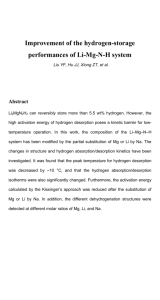
![DIRECT SYNTHESIS OF Li[BH4] FROM THE ELEMENTS](http://s3.studylib.net/store/data/006749722_1-3acc3b7e04414ccf23cb4364d250a1e7-300x300.png)



